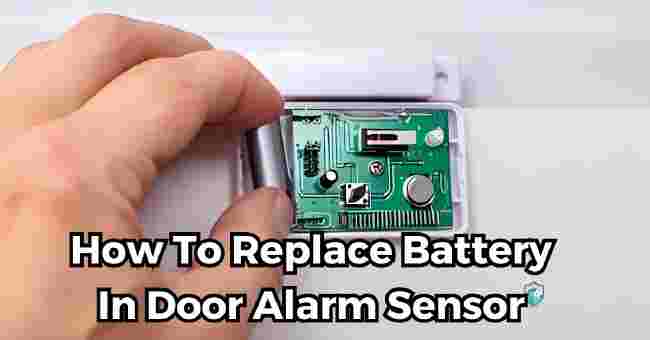Table of Contents
Are you tired of knowing how to replace battery in door alarm sensor? It’s a straightforward process to swap out the low power cell inside these wireless home security devices.
But I learned the hard way that even this basic maintenance can go wrong. Last year, the sensor on my back door started showing persistent low battery warnings that I kept ignoring.
Of course one night it failed completely silent while I was out, and didn’t trigger the alarm system when someone entered.
Thankfully only minor items got stolen, but it still felt like a personal violation. I could have avoided everything by properly replacing that sensor battery earlier.
So today, I’ll explain exactly how to safely change batteries in any wireless door contact unit to maintain protection.
This guide will cover everything you need to know to safely change the battery in your wireless door sensor in just a few minutes.
Why You Need to Replace That Low Sensor Battery ASAP
I know, home maintenance tasks like battery replacement probably fall pretty low on your to-do list.
But there are a couple big reasons you don’t want to procrastinate on this one:
- You’ll avoid false alarms and unnecessary service calls. As your door contact sensor‘s battery runs down further, the signal it sends to your security panel or monitoring center can get inconsistent.
Rather than correctly showing a door is shut and armed, the faulty power can make it look like your entry point suddenly opened, triggering nuisance alarm events. - Your system won’t work as intended during an actual break-in. On the flip side, you also want to catch that battery replacement before the wireless sensor dies completely.
Otherwise it will fail silently the next time your front door or ground floor window is compromised after arming your system. A dead contact sensor obviously can’t set off an alarm like it should when that entryway is disturbed.
Replacing these batteries only takes a few minutes per sensor. So do it ASAP once you get low battery alerts to keep your home and family protected.
Signs Your Door Alarm Sensor’s Battery is Running Low
Don’t wait until that “low battery” message pops up on the security keypad though – by then the power is on its last legs.
Watch for these other early warning signs:
- The small LED light on the sensor intermittently flashes. This is a battery-saving feature indicating payload power needs to be replaced soon.
- Your security panel or mobile app shows “trouble” or faulty readings from individual sensors. As voltage drops, their wireless communication becomes glitchy.
- The system triggers more false alarm events, especially overnight. Dying batteries may allow the contact sensor to temporarily cut out, breaking its alarm circuit connection.
Once you notice any of those issues above, go ahead and swap new batteries into ALL entry sensors. Don’t wait until each one shows faults individually.
It’s likely they were all installed around the same time, so their batteries will drain simultaneously.
Get ahead of additional trouble by changing batteries in all external door and window sensors at once.
What Type of Replacement Batteries Do You Need?
Before you crack open those alarm sensors to replace the batteries, make sure you have the right replacements on hand.
While most wireless units take cheap and common models like CR123 or CR2032 coin batteries, always check your owner’s manual to confirm. Some key details:
- Match your new batteries to the correct voltage (3V, 12V etc.), mAh rating, and physical size listed for your specific sensors.
- Purchase name brand batteries from manufacturers like Energizer, Duracell and Panasonic for longest operational life.
- Check the date codes or expiration dates and get batches that are Factory Fresh. Don’t buy packs that have been sitting on the retail shelf too long.
- Allow spares to acclimate – let them rest inside for 24 hours to adjust from hot or cold delivery truck temperatures before installing in sensors.
If possible, jot down the model numbers from each sensor or take photos so you know exactly what replacements to purchase for each model in use around your property.
| Battery Brand | Battery Type | Battery Life |
| Energizer | CR2032 | 1 year Duracell |
| Duracell | CR123A | 18 months |
| Panasonic | CR2 | 2 years |
Table: Common replacement batteries for home alarm sensors
Now let’s go step-by-step through the battery swap itself. The process is basically the same regardless of your monitored security provider or panel brand.
We’ll cover unique tips for popular providers like ADT and Honeywell where helpful.
How To Replace Battery In Door Alarm Sensor: 5 Steps To Fix It
- Carefully Open the Sensor Housing
- Remove the Dead Battery
- Insert the New Wireless Alarm Sensor Battery
- Reassemble the Sensor Housing
- Reinstall Your Door Contact Sensor
Step 1: Carefully Open the Sensor Housing
The first step is accessing that depleted energy source safely inside its plastic shell without triggering any tamper alarms:
- If the sensor has a screw holding the housing closed, loosen this completely using a small Phillips-head screwdriver.
- For snap-fit designs without a visible exterior screw, locate the subtle slot or latch allowing you to gently pry open the case. Insert the screwdriver tip, guitar pick, or small flat plastic tool to release the tabs holding the two halves together.
*Pro Tip: Position the sensor upside down as you work so the old battery doesn’t fall out when separating the housing!*
Step 2: Remove the Dead Battery
Once able to access the battery compartment, carefully slide out the expired power source. Replace it with your new battery in the next steps.
If dealing with smaller button-style cells, a short length of scotch tape folded over the end can help extract it by sticking to the surface (just don’t pull the internal connection tabs or wires). You’ll want to grab both sides of bigger cylindrical batteries.
Important: Ensure metal tools don’t short across the small terminal contacts inside the battery holder during this step.
Step 3: Insert the New Wireless Alarm Sensor Battery
Here’s where paying attention to polarity matters. Examine how the old battery was positioned in the compartment including which end was positive (+) or negative (-). Match that orientation putting in the fresh cell.
You’ll risk shorting out the compact circuit board if you accidentslly reverse the alignment. Double check that the new battery matches the original:
- Positive (+) terminal pointing toward the POS, P+ or side with a red wire attached
- Negative (-) terminal contacts the spring or black wire side
Gently push down the new power unit into place without bending or distorting the thin metal electrical contacts around it.
Step 4: Reassemble the Sensor Housing
Before snapping the plastic shell back together, do a quick inspection that:
- Wires or antenna contacts aren’t pinched or crushed
- The battery sits flat in its compartment
- Any water seal or gasket remains intact if originally equipped
Reattach the halves, taking care not to over tighten small case screws if equipped. You don’t want to crack plastic housings or strip screw heads here. The sensor doesn’t require much mechanical tension to securely contain the battery and circuit board.
*Warning: Overtightening sensor case screws is a common “newbie” mistake and can damage the plastic housing or internal electronics.*
If the battery compartment has an external slide cover or door, confirm it can re-engage smoothly to avoid rattling loose over time.
Step 5: Reinstall Your Door Contact Sensor
You’re almost finished – just reaffix the newly energized sensor in its original orientation:
- Position matters to maintain the proper small magnetic gap once you reinstall sensors on doors/windows and adjacent frame or casing. Mount units perfectly parallel and straight for reliable spacing.
- Check alignment by activating/separating the sensor while watching your keypad or mobile app for realtime response. Adjust mounting position until you get solid connectivity showing open/closed status updating.
- A small bubble level can help keep units oriented properly if appearance seems crooked. They should be perfectly plumb vertically and not tilted at an angle.
- Run through full arming/disarming cycles and intentionally open protected doors or windows where sensors are located. Your panel and mobiel app should show breach/secure updates in real time when disturbances occur.
And that’s the complete DIY process. Swapping a flat pancake battery only takes a few minutes once you’ve gathered the correct replacement and tools.
Now your sensor will be ready for another 1-2 years of reliable service protecting your home.
What About My ADT or Honeywell Sensors?
Third party security providers often rebrand sensors manufactured by other companies, or optimize them to work with proprietary systems.
But generally off the shelf models from GE, Interlogix, Napco, DSC and 2GIG are just adapted. So while minor housing differences may exist externally, the internal battery compartments are mostly similar.
Here are just a few sensor-specific considerations if you have a major home security provider:
ADT
- Entry sensors made by Honeywell are common on ADT systems. But also look for circular ADT logo stickers which may indicate custom models.
- Older ADT systems used 5800PIR motion and 5816 door/window sensors containing 3V CR123A cameras batteries. Newer equipment operates at lower voltages.
- Know your ADT equipment generation model number from paperwork or engraved sensor tags to pinpoint correct replacement battery specifics.
Honeywell
- Lyric and Vista control panels employ multiple sensor form factors all requiring CR123 batteries.
- ACHR2BLE look-alike sensors take the less common CR2450 coin batteries – don’t mix these up.
- Peel off any labels to check for hidden battery cover release tabs.
No specialty tools or provider tech visits needed for battery replacements – now that you know the straightforward process!
Avoiding Sensor Trouble After Swapping Batteries
A few final best practices will ensure your freshly powered sensors stay problem-free for the long run:
Give sensors time to sync
Expect the sensor status to show “faulty” or communication errors immediately after a battery swap.
Leave affected units mounted for 15-30 minutes to reestablish encrypted wireless pairing with the system before assuming anything got wired incorrectly.
Avoid false tamper triggers
Opening sensor housings trips tamper detection circuits until covers get reinstalled properly – your keypad may briefly show fault trouble during battery changes as a result.
Check other sensor batteries
If one wireless sensor needed a battery change, it’s likely the remaining ones around your home are running low too.
Proactively replace all exterior door and window sensor batteries rather than waiting for individual failure alerts later.
Extending Home Alarm Sensor Battery Life
You can optimize power consumption for longer operational life between battery changes:
Reduce Transmitted Check-Ins: If sensor batteries are dying much faster than their rated lifespan, reduce the heartbeat check-in frequency these transmit to the control panel. This also saves on wireless data usage.
Turn Off Status LEDs: Some sensors offer a DIP switch or option in app to disable the external status light. This eliminates an unnecessary (but small) power drain.
Buy A Higher Capacity Model: When shopping replacement door sensors upon bigger system upgrades or enhancements down the road, seek out models with higher capacity batteries and voltage regulating circuitry.
Though costing a few dollars more, these can last 5+ years on a set of batteries with reduced maintenance headaches.
FAQs
Do Door Alarm Sensors Have Batteries?
Yes, most wireless door and window sensors designed for home security systems run on small batteries to allow installation anywhere without requiring wiring.
Batteries power the sensors’ internal circuitry and wireless transmitter to communicate open/closed status to the control panel.
Popular battery types built into sensors include coin cell CR2032, CR2450 or CR123. Sensors last 1-5 years on a set before needing replacement.
Where Is The Battery In A Door Sensor?
Batteries are contained in a sealed compartment on the interior of wireless sensors.
The actual location varies between models but is typically accessible by gently prying apart the sensor housing, which may use small screws or snap-fit tabs to secure. Once opened, the battery will be mounted to a circuit board.
How Do I Know If My Battery Sensor Is Bad?
Warning signs of a failing sensor battery include:
- Intermittent low battery or fault alerts displayed on the security system keypad
- The small LED light on exterior of the sensor blinks rapidly
- Increased false alarms or missed events when doors/windows are disturbed
Any of those issues indicate depleted batteries needing immediate swap in the affected sensor.
How Do You Connect A Sensor To A Battery?
Sensor batteries connect to small circuit boards using thin metal tabs or spring contacts.
Pay close attention to polarity markings so positive and negative orientation matches original when replacing battery.
Avoid directly touching battery contacts to prevent dangerous shorts. Ensure wires, antenna or other components are not pinched when reassembling sensor housing.
What Batteries Do Door Sensors Use?
Popular batteries built into wireless security sensors for power include:
- CR2032 – Coin style, 3V lithium
- CR123A – Cylindrical 3V lithium
- CR2450 – Coin style 3V lithium
- CR2 – Cylindrical lithium
Check manual of your specific sensors to confirm correct replacement needs. Match size, voltage and mAh rating when purchasing new batteries.
How Long Do Door Sensor Batteries Last?
Depending on type and usage factors, wireless sensor batteries last 1 to 5 years before needing replacement.
Models supporting lower voltage thresholds, power saving sleep modes and less frequent wireless check-in transmissions offer greatest battery lifespans exceeding 3+ years per set of batteries under typical use conditions.
Why Does My Door Sensor Keep Beeping?
Beeping noises from a door/window sensor indicate low battery power needing replacement or separated sensor/magnet triggering tamper alert.
If battery was recently changed, check sensor alignment ensuring it is perfectly parallel to the magnet mounted on door frame to maintain tight 1/2″ gap clearance.
How Do I Stop My Door Alarm From Beeping?
To stop beeping noises from a door sensor, first replace battery if low power alerts are activating.
For persistent beeping even with good batteries, the sensor housing likely separated slightly from movement triggering the tamper circuitry.
Carefully realign sensor perfectly straight and 1/2″ from frame magnet by repositioning mounting tape/screws.
How Do You Stop A Door Sensor From Beeping?
Persistent beeping from a door sensor with good batteries typically means it shifted position slightly and needs realignment.
The tamper circuit triggers if spacing change moves sensor too far from the aligned magnet.
Disable the system, relevel and securely remount sensor parallel and 1/2″ from frame magnet to stop fault beeping alerts. Check wires are not pinched between housing halves when closed.
How Long Should Wireless Security Sensor Batteries Actually Last?
It depends on the battery capacity, transmission frequency, activation cycles, and environmental factors.
But generally plan on replacement every 1-3 years. Systems supporting lower battery voltage thresholds and sleep modes provide the maximum sensor battery lifespans.
Where Do I Dispose Of Dead Home Alarm Batteries Properly?
Defective lithium batteries require special recycling and contain hazardous contents unsafe for general refuse like your curbside trash pickup.
Instead take dead batteries to a retail drop off point, hazardous materials facility, or arrange battery recycling service through your city if provided.
Why Does My Sensor Show Inactive After Changing The Battery?
Sensors and control panels require several minutes to reestablish encrypted communication, transmit identification codes, and resync after losing power.
Leave the sensor mounted in location for 15+ minutes before assuming something got damaged or miswired during the battery swap.
Conclusion
Maintaining your security sensors properly allows your home alarm equipment to work as intended, while avoiding headaches from false alarms and unnecessary service calls.
Take battery replacement seriously to keep critical sensors operational 24/7 protecting your property.
Just follow manufacturer recommended battery specs, handle units carefully during the swap, and ensure proper physical alignment reinstalling sensors on doors and windows afterward.
Changing discharged batteries is a quick DIY process needing basic tools and new power sources readily available at popular retailers like Walmart, Costco, or Amazon. Now you have no excuse not to fix that flashing “low battery” warning light right away.
Replacement guides for most major panel brands and security providers explains the straightforward steps any homeowner can handle safely in about 5 minutes per sensor.




